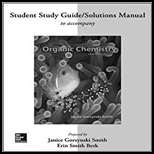
Concept explainers
(a)
Interpretation: The stronger nucleophile out of
Concept introduction: Solvent is required to dissolve the starting material in it. The substitution reaction involves polar starting reactant which is soluble in polar solvent. A solvent in which hydrogen atom is bonded to electronegative
(b)
Interpretation: The stronger nucleophile out of
Concept introduction: Solvent is required to dissolve the starting material in it. The substitution reaction involves polar starting reactant which is soluble in polar solvent. A solvent in which hydrogen atom is bonded to electronegative
(c)
Interpretation: The stronger nucleophile out of
Concept introduction: Solvent is required to dissolve the starting material in it. The substitution reaction involves polar starting reactant which is soluble in polar solvent. A solvent in which hydrogen atom is bonded to electronegative
Want to see the full answer?
Check out a sample textbook solution
Chapter 7 Solutions
ORGANIC CHEMISTRY-STUDY GDE...-W/ACCESS
- Which nucleophile would prefer simple addition over conjugate addition? CH3MgBr NaCN CH3CH2NH2 (CH3CH2)2CuLiarrow_forwardWould you say its sn1 ir sn2, I said it was sn1,because the nucleophile is weak, but my teachers said it was sn2arrow_forwardOptions for each: blank 1: A B blank 2: it has a better leaving group it is a polar aprotic solvent it has a stronger nucleophile blank 3: A B blank 4: it forms a more stable carbocation it has a better solvent it has a better leaving group blank 5: A B blank 6: it has a better solvent it has a better leaving group it has a stronger nucleophilearrow_forward
- explain why carbonyl compounds are so attractive to both nucleophiles and electrophilesarrow_forwardWhat is the first step in an SN1 reaction? Group of answer choices Attack of the nucleophile. Loss of the leaving group. Protonation of the leaving group.arrow_forwardIdentify the stronger nucleophile in each pair. a. NH3,−NH2 b. CH3NH2, CH3OH c. CH3CO2−, CH3CH2O−arrow_forward
- Circle the best nucleophile in ammonia: NaCl, NaOH, NaCH3, Nal Circle the best nucleophile in acetone: NaCl, NaOH, NaCH3, Nalarrow_forwardWhat is the right reagent in the reaction belowarrow_forwardCan you match best nucleophile / conditions from the list that will give a successful hydrolysis reaction for each electrophile? (there's one best nucleophile / conditions for each electrophile) <List for Nucleophile / condition> a. LiAlH4; hydronium work-up b. PCC c. NaH d. CrO3 e. HOEt f. H3O+ or OH- g. H2O h. NaBH4;hydronium work-up Electrophile 1. Acid chloride 2. Acetic anhydride 3. Ester 4. Amide I'm asking again on bartleby because pther tutor gave me the right answer because I think I didn't make my question clear enough.arrow_forward
- Which side of the equilibrium is favored in this acid/base rxn? pka of product: 6.9arrow_forwardFor problem 8.17, all of the reactions will be SN2. For each reaction, identify and evaluate each nucleophile (strong? weak? Strong or weak as a base?) Also, evaluate each solvent as polar protic or polar aprotic. I recommend drawing the structure of each solvent.arrow_forwardFor each reaction below identify the electrophile and the nucleophile.arrow_forward
 EBK A SMALL SCALE APPROACH TO ORGANIC LChemistryISBN:9781305446021Author:LampmanPublisher:CENGAGE LEARNING - CONSIGNMENT
EBK A SMALL SCALE APPROACH TO ORGANIC LChemistryISBN:9781305446021Author:LampmanPublisher:CENGAGE LEARNING - CONSIGNMENT Organic Chemistry: A Guided InquiryChemistryISBN:9780618974122Author:Andrei StraumanisPublisher:Cengage Learning
Organic Chemistry: A Guided InquiryChemistryISBN:9780618974122Author:Andrei StraumanisPublisher:Cengage Learning

